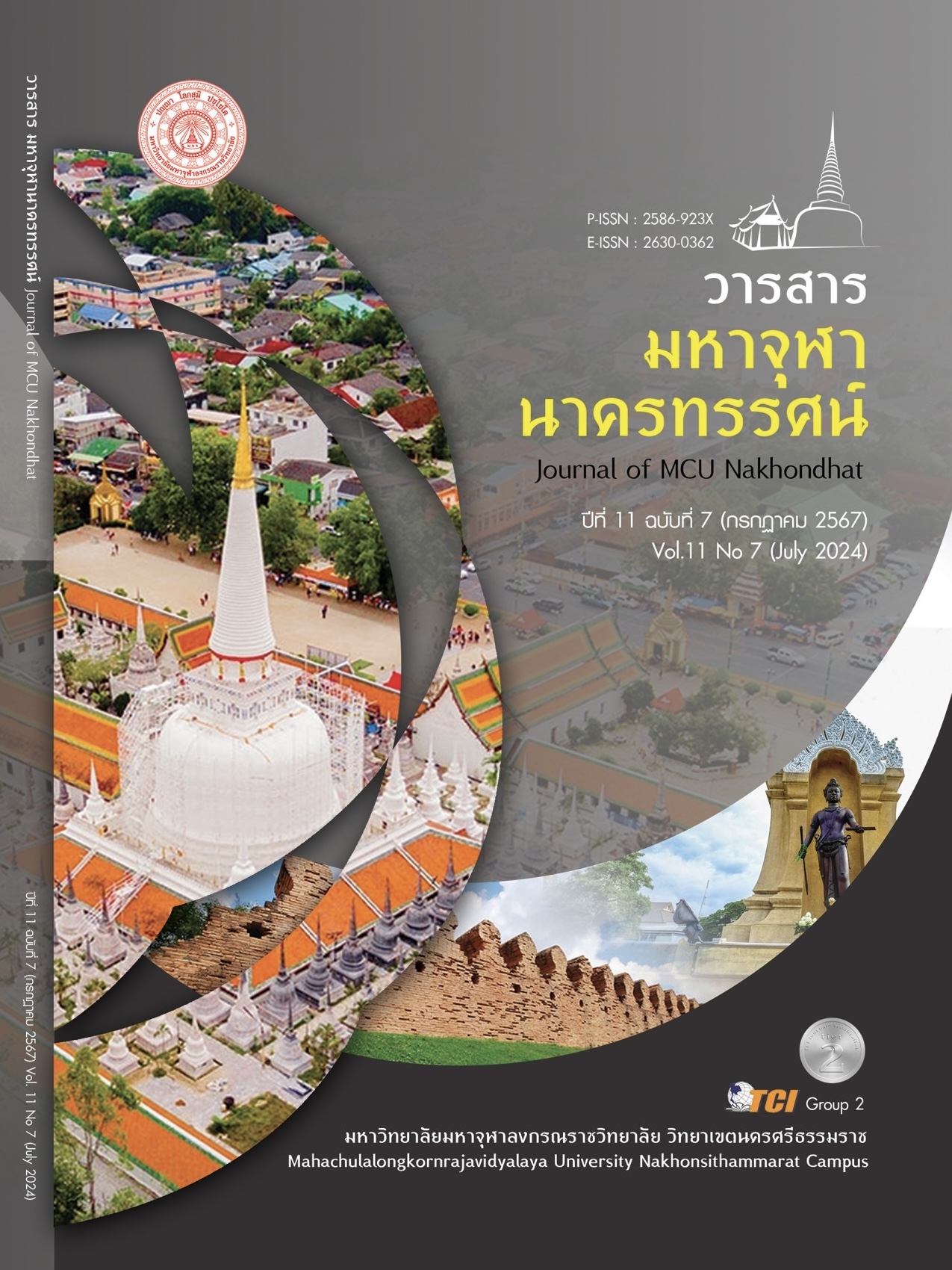THE RELATIONSHIP BETWEEN SCHOOL ADMINISTRATORS’ AGILE LEADERSHIP AND SCHOOL TEACHERS’ JOB MOTIVATION UNDER THE SUPERVISION OF SAMUTPRAKARN PRIMARY EDUCATIONAL SERVICE AREA OFFICE 1
Main Article Content
Abstract
This research aimed to study 1) The level of school administrators’ agile leadership under the supervision of Samutprakarn Primary Educational Service Area Office 1; 2) The level of job motivation; 3) The relationship between the school administrators’ agile leadership and job motivation; and 4) The guidelines for developing school administrators’ agile leadership to enhance schoolteachers’ job motivation. A mixed-methods research approach was employed. The sample group consists of 306 schoolteachers, selected through stratified random sampling based on school sizes. The research tools used were a 5-point Likert scale questionnaire with a reliability of 0.973 and an interview form. The data were analyzed by using statistics, mean, standard deviation, Pearson correlation coefficients, and content analysis. The results revealed that 1) The overall and individual aspects of agile leadership among school administrators were found to be at a high level; 2) School teachers’ job motivation, both overall and in specific areas, was at a high level; 3) The relationship between the school administrators’ agile leadership and teachers’ job motivation was positive at the very high level at the significance level of .01; 4) The guidelines for developing school administrators’ agile leadership to enhance teachers' job motivation consisted of 4 aspects as follows: 4.1) There were three guidelines for developing context-setting agility in enhancing work itself-related motivation; 4.2) There were six guidelines for developing stakeholder agility in enhancing work itself-related motivation; 4.3) There were seven guidelines for developing creative agility in enhancing work achievement-related motivation; 4.4) There were four guidelines for developing self-leadership agility in enhancing work achievement-related motivation.
Article Details

This work is licensed under a Creative Commons Attribution-NonCommercial-NoDerivatives 4.0 International License.
References
จิราเจต วิเศษดอนหวาย. (2566). ลาก่อน VUCA มาแล้ว BANI : ชวน ผอ. ปรับตัวและโรงเรียนให้ทันการเปลี่ยนแปลง. เรียกใช้เมื่อ 6 เมษายน 2566 จาก https://www.educathai.com/knowledge/articles/652
ดลญา พุดทอง และสมหมาย อ่่าดอนกลอย. (2557). การศึกษาความสัมพันธ์ของภาวะผู้นำมุ่งความสำเร็จของงานของผู้บริหารสถานศึกษากับความพึงพอใจในการทำงานของครู สำนักงานเขตพื้นที่การศึกษาประถมศึกษาพิษณุโลก เขต 2. วารสารมนุษยศาสตร์และสังคมศาสตร์มหาวิทยาลัยราชภัฏพิบูลสงคราม, 8(2), 43-57.
นูรียะห์ หะแว. (2564). พฤติกรรมผู้นำของผู้บริหารสถานศึกษากับแรงจูงใจในกราปฏิบัติงานของครูสังกัดสำนักงานเขตพื้นที่การศึกษาประถมศึกษายะลา เขต 2. ใน วิทยานิพนธ์ครุศาสตรมหาบัณฑิต สาขาการสอน. มหาวิทยาลัยราชภัฏยะลา.
บุญชม ศรีสะอาด. (2560). การวิจัยเบื้องต้น ฉบับปรับปรุงใหม่. (พิมพ์ครั้งที่ 10). กรุงเทพมหานคร: บริษัท สุวีริยาสาส์นจำกัด.
ปดิวรัดา เกิดสุข และคณะ. (2565). ความสัมพันธ์ระหว่างภาวะผู้นำแบบอไจล์ของผู้บริหารสถานศึกษากับประสิทธิภาพการทำงานของครูในโรงเรียนสังกัดสำนักงานเขตพื้นที่การศึกษามัธยมศึกษาสุรินทร์. วารสารบริหารการศึกษา มศว, 19(37), 51-62.
ประกาศกระทรวงศึกษาธิการ. (2560). เรื่องการแบ่งส่วนราชการภายในสํานักงานเขตพื้นที่การศึกษา พ.ศ. 2560. ราชกิจจนุเบกษา เล่ม 134 ตอนพิเศษ 295 ง หน้า 13 (29 พฤศจิกายน 2560).
ปราณี เข็มทอง. (2557). การศึกษาความสัมพันธ์ระหว่างภาวะผู้นำของผู้บริหารสถานศึกษากับความพึงพอใจในการปฏิบัติงานของครูผู้สอนสังกัดสำนักงานเขตพื้นที่การศึกษามัธยมศึกษา เขต 7. ใน วิทยานิพนธ์ครุศาสตรมหาบัณฑิต สาขาการบริหารการศึกษา. มหาวิทยาลัยราชภัฏรำไพพรรณี.
พัฒนศักดิ์ อภัยสม และคณะ. (2565). แบบภาวะผู้นำทางการศึกษายุคใหม่. วารสารวิชาการมหาวิทยาลัยราชภัฏศรีสะเกษ, 16(2), 1-12.
ภูวนาท เบ็ญจวรรณ์. (2563). การศึกษาภาวะผู้นำที่เหมาะสมกับการทำงานแบบคล่องตัว. ใน สารนิพนธ์มหาบัณฑิต สาขาการจัดการ. มหาวิทยาลัยมหิดล.
สำนักงานเขตพื้นที่การศึกษาประถมศึกษาสมุทรปราการ เขต 1. (2566). รายงานผลการดำเนินงานประจำปีงบประมาณ พ.ศ. 2566. เรียกใช้เมื่อ 25 พศจิกายน 2566 จาก http://bit.ly/3QGGokN
อภิวัฒน์ มรรคผล และอุไร สุทธิแย้ม. (2565). ภาวะผู้นำแบบ Agile ของผู้บริหารสถานศึกษาสังกัดสำนักงานเขตพื้นที่การศึกษามัธยมศึกษากรุงเทพมหานคร เขต 2. วารสารบัณฑิตศึกษา มหาวิทยาลัยราชภัฏสวนสุนันทา, 16(1), 64-87.
อรอุมา จันทนป. (2561). แรงจูงใจในการปฏิบัติงานของครูโรงเรียนโสตศึกษาจังหวัดนครปฐม. ใน วิทยานิพนธ์มหาบัณฑิต สาขาการจัดการ. มหาวิทยาลัยศิลปากร.
Cathcart Technology Thailand. (2565). The Future of Leadership: ภาวะผู้นำในยุค BANI ผ่านมุมมองของกระทิง ประธาน KBTG. เรียกใช้เมื่อ 25 พฤศจิกายน 2566 จาก https://cathcarttechnology.co.th/insights/the-future-of-leadership-by-krating-kbtg/
Cronbach, L. J. (1990). Essentials of Psychological Testing. (5th ed). New York: Harper Collins.
Douglas, E. (2023). Six Competencies of Agile Leaders. Retrieved April 8, 2023, from https://leading-resources.com/communication/six-competencies-of-agile-leaders/
Glass, G. V. & Hopkins, K. D. (1984). Statistical Methods in Educational and Psychology. Englewood Cliffs: Prentice-Hall.
Herzberg, F. (1992). The Motivation-Hygiene Theory. Handbook of Industrial and Organizational Psychology, 2(1), 129-156.
Joiner, B. & Josephs, S. (2007). Developing agile leaders. Industrial and Commercial Training, 39(1), 41-54.
Krejcie, R. V. & Morgan, D. W. (1970). Determining Sample Size for Research Activities. Educational and Psychological Measurement, 30(3), 607-610.


